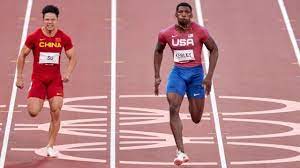The men’s 100-meter dash final in London 2012, in which 7 of the 8 sprinters completed the race in less than 10 seconds, was a sign of things to come. It was a sea change from track and field’s main event, but it is unlikely that the spectators inside London’s Olympic Stadium at the 2012 Games would notice.
Understandably, they were distracted watching Usain Bolt cross the finish line in the men’s 100m sprint competition. The Jamaican superstar won another gold medal that night and set the Olympic record for that race in 9.63 seconds. “It was one of the best races ever”, explains Steve Haake, Professor of Sports Engineering at Sheffield Hallam University in the UK.
But Haake does not just praise Bolt’s feat

His comment is motivated by the overall performance of the group of athletes: 7 of the 8 runners who participated in that final crossed the finish line in less than 10 seconds, something unprecedented. The 10-second barrier was first broken in 1968, but today it remains a great achievement for sprinters, a badge of honor that sets them apart from their peers.
The number of “under-10” runners has exploded in recent years
The U-10 club: Increased the number of male sprinters running 100 meters in less than 10 seconds.
67: The number of athletes who broke “the barrier” between 1968 and 2008.
87: The number of athletes who did it since 2009.
9.58 seconds: This is the current world record, set by Usain Bolt of Jamaica, in 2009.
According to data from World Athletics, the sport’s governing body, in the 4 decades between 1968 and 2008, only 67 athletes had broken the barrier. Another 70 would join the club in the next 10 years. And in the last 2 years, until the beginning of July 2021, 17 more men got their first “sub-10” races. The women’s equivalent barrier of 11 seconds is also being broken with increasing frequency.
What is happening? An ever expanding club
Scientists like Haake believe it is a combination of factors that begins with increasing participation in track events around the world, and access to better training methods. Today, “more athletes around the world are benefiting from elite training and the help of sports science and technology to improve their chances of running faster,” adds Haake.
The evidence is that the U-10 club has expanded beyond mainstream powerhouses like the United States and Jamaica and teams like Great Britain and Canada, which have won at least one Olympic gold medal in the men’s 100-meter dash.
Nigeria, for example, shares with Great Britain the third-highest number of athletes to break the 10-second barrier with 10 athletes, while newcomers to the club include Japan, Turkey, China and South Africa, countries less known for their excellence in sprinting.
Similar results are seen in the women’s 100 meter dash. The 11-second barrier was first broken in 1973 by East German sprinter Renate Stecher. By 2011, 67 other athletes had done so as well. Ten years later, the total is 115 and includes athletes from countries with less tradition in the event.
Footwear, tracks, and sports science

Technology has been helpful. Today’s sprinters run in shoes that are lighter. The latest models can weigh less than 150 grams and are made with radically different materials. One example is the collaboration between German footwear Puma and the Mercedes Formula One team, which resulted in racing shoes with carbon fiber soles, the same material that was used to design the car of multi-time world champion Lewis Hamilton.
Running tracks have also come a long way from the days when elite athletes raced on dirt or grass in competitions. Synthetic tracks made their Olympic debut at the 1968 Games in Mexico, offering more protection to athletes’ joints and promising a trampoline effect that would lead to faster times.
It was in those same Games that the American sprinter Jim Hines became the first human to run the 100 meter sprint in less than 10 seconds, more precisely: 9.95. The tracks are getting faster because now even the shape of the vulcanized rubber granules used to build the surface is being considered.
At the 2008 Beijing Games, Italian surface manufacturer Mondo celebrated the 5 world records set on the track that it supplied for athletics competition almost as much as the runners did.
Science also influenced nutrition and training
Today’s sprinters can be thoroughly analyzed and adjustments made to technique and reaction times. The researchers even identified which muscles are most important for sprinters to be successful.
The UK, a leading institution in sports science studies, found that the gluteus maximus (the muscle that forms the buttocks) is key for athletes to achieve top speeds on the track. “We now have the knowledge that there is a very specific muscle distribution in elite sprinters”, says Sam Allen, a biomechanics expert who participated in the research. “So we will soon see sprinters working specifically on that development”.
In an interview for the Japanese newspaper “The Asahi Shimbun” on July 9, local sprinter Ryota Yamagata did not hesitate to attribute breaking the 10-second mark in his 100-meter race a month earlier to “the work of scientists during the last 20 years”. No Japanese sprinter had cleared the barrier until 2017. Since then, Yamagata and 3 other compatriots have.
It also appears that the expansion of the U-10 club in terms of numbers and diversity is making the barrier less intimidating for athletes. That’s the opinion of Chinese Bingtian Su who, in 2015, became the first Asian-born man to run the 100 meters in less than 10 seconds.
The Chinese sprinter believes that the 10-second barrier is primarily a psychological challenge. “I think the barrier is more of a psychological thing than a physical thing”, he said in 2019.
Medal Mastery
Obviously, these advances are not an automatic guarantee of success in breaking the barrier. To date, for example, many countries, such as India, and even an entire continent (South America) have yet to produce a male athlete who breaks 10 seconds or a female runner who breaks the sub-11 barrier.
In fact, the expansion of the “under-10 club” has not really altered the competitive balance when it comes to winning medals. The victories in the 100-meter races remain a duopoly between the US and Jamaica. In both men’s and women’s events, sprinters from the USA and Jamaica have consistently dominated the podium in world championship and Olympic races since the 1980s.
In the men’s competition, for example, the last sprinter outside these countries to win Olympic gold was Canadian Donovan Bailey, at the 1996 Atlanta Games. In the women’s race, Yuilya Nestsiarenka’s victory at the 2004 Athens Games, it was a surprise even for the Belarus sprinter herself. The American athletes had won the races in the previous 5 Olympic Games and the Jamaicans were victorious in the next 3 editions.
Things are unlikely to change at the Tokyo Games, even though they are the first after Bolt’s retirement. American sprinters have 4 out of the 5 fastest times in the men’s 100-meter sprint in 2021, while 3 Jamaicans and 1 American are among the 5 fastest women on the planet, so far in 2021.


